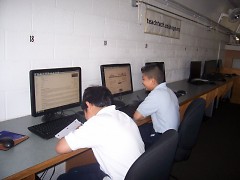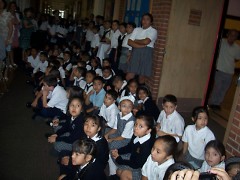Lowering drop out rates of high school Latino students in Grand Rapids means a special education beginning in kindergarten.
Data from the Grand Rapids Public Schools shows that Latino students test scores lag behind their peers more each year as they progress academically. In third grade, according to MEAP scores, Latino students rank near the average. Latino student scores fall off dramatically by high school. In eleventh grade they are scoring at 18% proficiency in math and 32% in reading. Compare that to statewide scores of 52% in math and 63% in reading and it’s clear that something needs changing.
One possible contributing factor is that the parents of the students come from poverty-ridden countries and in some cases are themselves uneducated. They may also possess only rudimentary English skills. As much as they want to help their children academically these factors make it difficult for Latino parents – especially new immigrants – to help their children as they encounter more sophisticated subjects and difficult language. Lack of parental involvement may contribute even more to Latino students falling behind as they age. It isn’t the only factor, but it is a significant one.
Gifted children and children of mentally impaired parents quickly surpass their parents in one or more subjects and yet they don’t stop progressing. Or take the extreme case of a savant child. Even that child finds a stimulating outlet for their mental capacity without regressing to the mean or below.
Even the typical child can succeed without parental involvement. Think of the movie “I am Sam.” Sean Penn plays a man with the mental capacity of an eight-year-old. When he fathers a child through less than perfect circumstances, the concern is that he won’t be able to help his daughter in school past the third grade. In the end Lucy, the daughter, does fine in school with the help of teachers and others. Maybe a bit romanticized, but not that far from reality.
So, what keeps Latino children from succeeding in school and what contributes to their devastating levels of attrition? Today’s children of immigrant parents face a greater barrage of media than the children of previous waves of immigration. The amount of media to which children are currently exposed is greater than previous generations. Not only is the quantity greater, it is available in their first language.
Previous generations of immigrant children were forced to learn English because there was no alternative. Limited English skills may be a minor issue in kindergarten. As the student progresses in school, the disadvantage to limited English vocabulary typically increases. This is commonly results in lower reading comprehension and an inability to understand and follow written instructions.
There are a number of other elements that can contribute to the Latino achievement gap. Children living in poverty usually have greater difficulty in school. Latinos are often impoverished. In fact, according to City-Data.com, 39.6% of Grand Rapids’ Latinos live below the poverty level. That compares to 24.1% of the Grand Rapids population as a whole. Even cultural differences play into the equation.
Given the obstacles Latino children face, they may have needs that are beyond the resources available in public schools. After all, the public schools by their very nature don’t specialize in the needs the few. Public schools are designed to educate the “typical” rather than those with special needs and unique backgrounds.
There are alternatives in Grand Rapids for Latino parents looking for a school more attuned to their child’s cultural background and needs.
San Juan Diego Academy, located at 1650 Godfrey on the border of Wyoming and Grand Rapids, specializes in providing an education to the children of Latino immigrants and increasing their graduation rates. It does this through a proven curriculum that stresses English-based reading and communication skills, creating an atmosphere of high academic expectations and moral vigor, honoring the immigrant culture and inviting parents to be partners in this process.
This doesn’t come without effort. It comes from a combined family and school systemic approach. The school provides an extended school day and teachers who are dedicated to the school’s mission. The school provides an English as a Second Language (ESL) program where parents and children can study English together. Parents involved in their child’s academic success by helping them with their homework. Additionally, many parents have a physical presence at school as volunteers.
With the Latino population expanding faster than any other minority, addressing the needs of this segment of the population cannot be underestimated.
In his speech in Grand Rapids last fall, Marcelo Suárez-Orozco, co-founder of the Harvard Immigration Project and professor of globalization and education at New York University, emphasized the point when he noted that the number of Latinos under the age of 18 has increased by 5.5 million in the last decade alone.
“These are the teachers, the firefighters, the cops, the scientists- this is the future of the United States. These are your new citizens,” he said. “For those of you in business, these are your new customers."
The best interest of our community is to reduce the high school dropout rate and narrow the achievement gap for our Latino children. They are the new citizens of today and the backbone of tomorrow.
The Rapidian, a program of the 501(c)3 nonprofit Community Media Center, relies on the community’s support to help cover the cost of training reporters and publishing content.
We need your help.
If each of our readers and content creators who values this community platform help support its creation and maintenance, The Rapidian can continue to educate and facilitate a conversation around issues for years to come.
Please support The Rapidian and make a contribution today.



